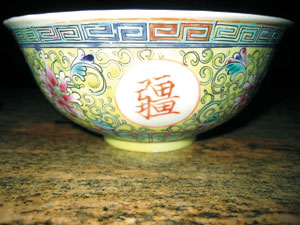
Robin sent me a photo of a yellow, pink and blue Chinese Ceramics bowl that she bought at a yard sale for $10 a few years ago. Her question: Is it worth more than $10?
A big question for a big field: Chinese ceramics. As an art form, only ceramics cover the entire 45 centuries of Chinese history, the most enduring of all art forms, and the most prolific. The test of an art form’s aesthetic achievement shows in the successful merger of content and form. The clay, fired, the content, and the simplicity of the shapes made in Asian ceramics, the form. The same forms served aesthetically successful, pleasing to the eye and hand, for 45 centuries. As a result some shapes of pots never changed, making it difficult for an appraiser to date Chinese ceramics accurately. Suffice it to say, the influence of Chinese ceramics on the world became profound.
Chinese Ceramics Vary
Different Chinese ceramics include clay, stoneware, soft paste, earthenware, and porcelain, discovered in China as early as 220 CE. Porcelain comprises Robin’s bowl. It uses a unique chemical composition, making it strong, hard, white, translucent and ring when you ping it with a fingernail. Glazed or unglazed, it holds water, unlike other ceramics.
Historians divide the history of Chinese ceramics, although weighty, into two definite time periodsm before 1750 and after 1750. Why this date? The Chinese emperor organized European trade through the Canton System to control exports. At this point Chinese ceramists developed ceramics for the European trade. European traders coming to Canton in the 18th century looked for silks, porcelain and tea, and bought so much tea that money ran dry. So European traders who also traveled to India (a British colony) brought the Chinese opium instead of cash.
Along with opium, European traders brought forms of vessels for Chinese porcelain makers to copy. Because Europe didn’t discovered the secret to porcelain’s chemical composition, European traders brought models of tableware desired by the 18th century European table in silver forms. Thus, for one of the first times in the history of design, a three-pronged design aesthetic emerged. They called this Chinese export porcelain.
The three prongs
Chinese designers accustomed to traditional Chinese forms and simple designs, the forms used for models, say a porcelain teapot representing a sterling silver (British) teapot, and, finally, the painted designs were European as translated by a Chinese artist. Therefore, some first designs on Chinese export porcelain became three-masted schooners and European coats of arms, appeared not as Europeans painted them.
Before the end of the 18th century, all noble families in Europe had ordered a service of Chinese export porcelain for the table with their coat of arms or a design around a family name.
The next event in the history of Robin’s bowl is the switch from European-ordered designs in China to Chinese designs for export, with the growing understanding of what Europeans bought. Therefore the color palettes took on a European flavor: blues, pinks, yellows, pastels not the Chinese taste. The famille-style (the French term for color groupings) was born: famille jaune, noire, rose and verte. My favorite is famille rose, delicate pinks and greens with figures of Asian beauties.
Now, Robin, all this may excite you, but here’s the bad news: Your bowl is a 20th-century reproduction of an older form. I know this because Chinese export porcelain is thinner than your bowl’s porcelain, as well as slightly less white; blue-gray in cast.
What is Robin’s bowl worth? $10!